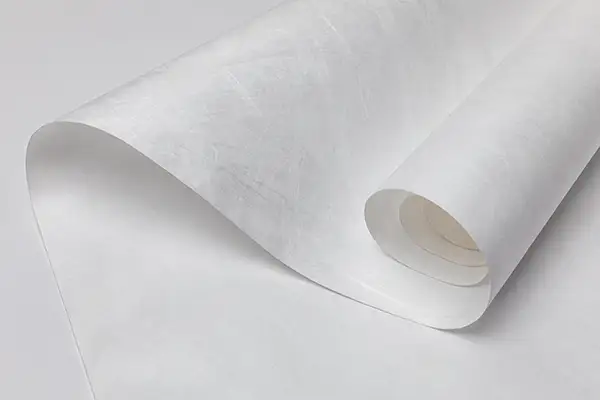What Is Tyvek®?
Tyvek® is a brand of highly durable and versatile material made by DuPont™, known for its ability to keep moisture out while allowing air to pass through. It is a spunbonded, non-woven synthetic material that is primarily composed of high-density polyethylene (HDPE) fibers.
The History of Tyvek®

In 1955, DuPont researcher Jim White made a curious discovery that would change the materials world forever. He noticed some white polyethylene “fluff” coming out of a pipe in a laboratory at the company’s Experimental Station in Alapocas, DE. White noted that this material was lightweight, durable, and appeared to be water resistant.
What followed was years of research and development to determine the appropriate manufacturing process to create sheets of this material. Finally, a flash-spinning process invented by Herbert Blades, a DuPont scientist, proved effective for creating sheets of durable paper-like material made up of a dense web of tightly-bound HDPE filaments.
DuPont created the first version of what would become Tyvek® in 1959 and began exploring uses for it. The initial intended use was to make waterproof book covers. The company officially trademarked the Tyvek® brand name in 1965 and made it available for commercial use in April 1967.
During the 1970s, the construction industry began using Tyvek® to keep water and wind from damaging in-process build projects. As an added bonus, the material was breathable enough to allow water vapor to escape and thereby prevent formation of mold and mildew.
As of 1972, DuPont also realized the usefulness of Tyvek® as packaging material for medical instruments due to its microbial barrier properties and ability to allow many types of sterilization. During the 1980s, Tyvek® became the first choice in materials for sterilizable medical device packaging.
The unique properties of Tyvek® have lead to its use in other applications, such as protective clothing, mailers and envelopes, wristbands and clothing tags, desiccant and oxygen absorber packets, cargo protection, and fashion - many designers have made waterproof, breathable garments from Tyvek®. The material has also been used in the past by governments to make currency and identification cards due to its tear resistance and printability.
No Longer Unique?
In recent years, other manufacturers have developed the ability to create materials that are functional alternatives from Tyvek®. For example, IMPAK's new TeknaPore™ is available in multiple grades and exhibits durability, breathability, printability, and water resistance properties identical to what DuPont offers.
Tyvek® characteristics:
- Water-resistant: Tyvek® is highly resistant to water and moisture, which makes it suitable for applications where protection against liquids is essential.
- Breathable: Despite its water resistance, Tyvek® is breathable, allowing air and moisture vapor to pass through, which is useful for certain applications like protective clothing and house wraps.
- Tear-resistant: It has excellent tear resistance, making it robust and able to withstand rough handling.
- Microbial barrier: Tyvek® provides a strong barrier to microorganisms, making it ideal for sterile instrument packaging.
- Chemical resistance: It shows good resistance to many chemicals, and is suitable for applications where chemical exposure might be a concern.
- Lightweight: Tyvek® is lightweight, making it easy to handle and transport.
Tyvek® applications:
- Packaging: Many sensitive items are packaged in Tyvek®, such as electronics and medical devices, to protect them from moisture and physical damage.
- Medical and healthcare: Tyvek® is used in medical packaging, sterilization wraps, and medical apparel like surgical gowns and drapes.
- Protective clothing: Tyvek® is commonly used for disposable coveralls, lab coats, and other protective apparel in various industries, providing a barrier against hazardous materials and substances.
- Construction: It is used as a house wrap, providing a breathable yet water-resistant barrier for buildings, protecting them from external elements while allowing moisture vapor to escape from inside.
- Envelopes and mailers: Tyvek® is used for durable and tear-resistant envelopes to protect documents during shipping.
- Tags and labels: Due to its tear-resistant nature, Tyvek® is often used for tags, labels, and wristbands that require durability.
It's important to note that Tyvek® is a registered trademark of DuPont™, and similar materials made by other manufacturers may be referred to as "spunbonded olefin" or "spunbonded polyethylene."
IMPAK Has Tyvek®-Alternate Materials
IMPAK is proud to offer TeknaPore™ structures that are comparable to Tyvek® 1073B and 2058C, used primarily for sterile medical instrument packaging and active food packaging, respectively. Consult with one of our technical experts about product development using these structures.
